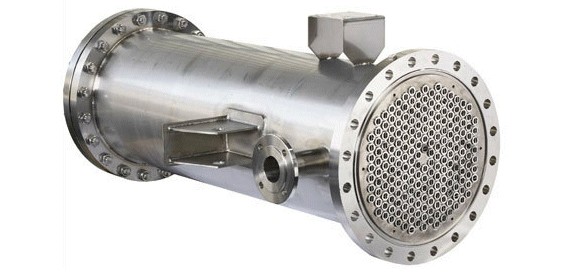Chemical and Process Engineering Resources

The surface area A of heat exchangers required for a given service is determined from
![]()
where
QÂ Â Â Â = rate of heat transfer
UÂ Â Â Â = mean overall heat transfer coefficient
ΔTm  = mean temperature difference
For a given heat transfer service with known mass flow rates and inlet and outlet temperatures the determination of Q is straightforward and ΔTm can be easily calculated if a flow arrangement is selected (e.g. logarithmic mean temperature difference for pure countercurrent or cocurrent flow). This is different for the overall heat transfer coefficient U. The determination of U is often tedious and needs data not yet available in preliminary stages of the design. The following is a table with values for different applications and heat exchanger types. More values can be found in the sources given below.
The ranges given in the table are an indication for the order of magnitude. Lower values are for unfavorable conditions such as lower flow velocities, higher viscosities, and additional fouling resistances. Higher values are for more favorable conditions. Coefficients of actual equipment may be smaller or larger than the values listed. Note that the values should not be used as a replacement of rigorous methods for the final design of heat exchangers, although they may serve as a useful check on the results obtained by these methods.
| Type | Application and Conditions | U W/(m2 K)1) |
U Btu/(ft2 °F h)1) |
| Â | Â | Â | Â |
| Tubular, heating or cooling | Gases at atmospheric pressure inside and outside tubes | 5 - 35 | 1 - 6 |
| Â | Gases at high pressure inside and outside tubes | 150 - 500 | 25 - 90 |
| Â | Liquid outside (inside) and gas at atmospheric pressure inside (outside) tubes | 15 - 70 | 3 - 15 |
| Â | Gas at high pressure inside and liquid outside tubes | 200 - 400 | 35 - 70 |
| Â | Liquids inside and outside tubes | 150 - 1200 | 25 - 200 |
| Â | Steam outside and liquid inside tubes | 300 - 1200 | 50 - 200 |
| Â | Â | Â | Â |
| Tubular, condensation | Steam outside and cooling water inside tubes | 1500 - 4000 | 250 - 700 |
| Â | Organic vapors or ammonia outside and cooling water inside tubes | 300 - 1200 | 50 - 200 |
| Â | Â | Â | Â |
| Tubular, evaporation | steam outside and high-viscous liquid inside tubes, natural circulation | 300 - 900 | 50 - 150 |
| Â | steam outside and low-viscous liquid inside tubes, natural circulation | 600 - 1700 | 100 - 300 |
| Â | steam outside and liquid inside tubes, forced circulation | 900 - 3000 | 150 - 500 |
| Â | Â | Â | Â |
| Air-cooled heat exchangers2) | Cooling of water | 600 - 750 | 100 - 130 |
| Â | Cooling of liquid light hydrocarbons | 400 - 550 | 70 - 95 |
| Â | Cooling of tar | 30 - 60 | 5 - 10 |
| Â | Cooling of air or flue gas | 60 - 180 | 10 - 30 |
| Â | Cooling of hydrocarbon gas | 200 - 450 | 35 - 80 |
| Â | Condensation of low pressure steam | 700 - 850 | 125 - 150 |
| Â | Condensation of organic vapors | 350 - 500 | 65 - 90 |
| Â | Â | Â | Â |
| Plate heat exchanger | liquid to liquid | 1000 - 4000 | 150 - 700 |
| Â | Â | Â | Â |
| Spiral heat exchanger | liquid to liquid | 700 - 2500 | 125 - 500 |
| Â | condensing vapor to liquid | 900 - 3500 | 150 - 700 |
Sources
Schlünder, E. U. (Ed.): VDI Heat Atlas, Woodhead Publishing, Limited, 1993, Chapter Cc.Perry, R. H., Green, D. W. (Eds.): Perry's Chemical Engineers' Handbook, 7th edition, McGraw-Hill, 1997 , Section 11.
Kern, D. Q.: Process Heat Transfer, McGraw-Hill, 1950.
Ludwig, E. E.: Applied Process Design for Chemical and Petrochemical Plants, Vol. 3, 3rd edition, Gulf Publishing Company, 1998.
Branan, C. R.: Process Engineer's Pocket Handbook, Vol. 1, Gulf Publishing Company, 1976.

 FB
FB



0 Comments